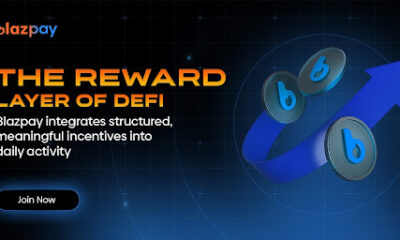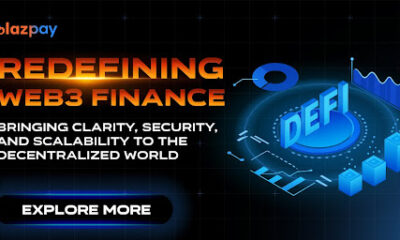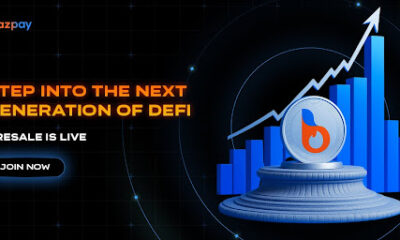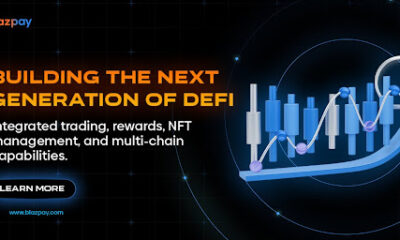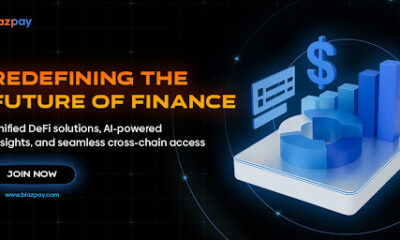Blockchain
7 Cryptos to Watch This November – Why Blazpay Could Be the Next Big Crypto Coin for 100x Gains

As the crypto market gains momentum heading into November 2025, investors are zeroing in on the next big crypto coin that can deliver exponential returns. While established giants like Ethereum (ETH) and Binance Coin (BNB) continue to dominate by market cap, new entrants such as Blazpay are turning heads for their innovative AI integration, SDK-driven ecosystem, and high-growth potential.
In a space overflowing with speculation, presale cryptocurrencies are proving to be the most strategic entry points. Among them, Blazpay stands out as a next big crypto coin contender thanks to its real-world utilities, unified services, and advanced multi-chain structure, making it a true evolution of what crypto AI technology can achieve.
1. Blazpay (BLAZ) – The Next Big Crypto Coin with Real AI and SDK Power
Blazpay (BLAZ) isn’t just another presale cryptocurrency, it’s a full ecosystem designed for scalability and real-world adoption. Currently in Phase 3 of its presale, Blazpay is priced at $0.009375 per BLAZ, with over 184 million tokens sold and $1.52 million raised, reflecting over 91% completion of this round.
What makes Blazpay a standout next big crypto coin is its AI SDK (Software Development Kit), a tool designed to let developers easily integrate blockchain-based payments, loyalty programs, and AI-powered analytics into their own apps or services. This simplifies adoption and creates a web of interconnected ecosystems powered by Blazpay’s unified multi-chain layer.
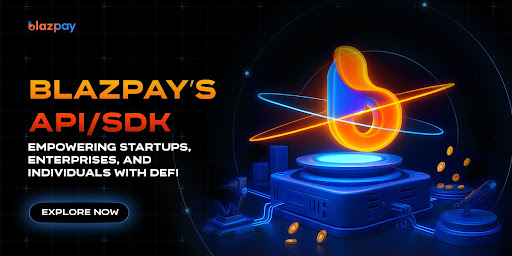
Key Utilities: SDK and Multi-Chain Infrastructure
Blazpay is built on a multi-chain network supporting Ethereum, BNB Chain, and Solana integrations, ensuring instant transactions and reduced gas fees. Combined with its SDK, businesses and developers can easily build dApps, exchanges, or DeFi tools without starting from scratch.
This powerful combination makes Blazpay not only a crypto AI innovator but also one of the best 100x crypto candidates to emerge in 2025.
Blazpay’s Referral Rewards – Instant USD Earnings
One of the most exciting features pushing Blazpay ahead of traditional cryptos like Ethereum and Solana is its instant referral reward system.
Through Blazpay’s Referral Rewards Program, users can earn instant USDT rewards for each successful referral, a feature rarely seen in other presale cryptocurrencies. What sets it apart is the ability to instantly withdraw these rewards, allowing participants to generate real-time USD income during the presale phase itself.
This direct earnings model adds another layer of value to Blazpay’s growing appeal as the next big crypto coin, merging the excitement of presale growth with tangible, daily profit potential.
2. Ethereum (ETH) – The Established Innovator Still Holding Strong
Ethereum remains the backbone of decentralized applications and smart contracts. It’s no surprise that even as new presale cryptocurrencies enter the spotlight, Ethereum still commands a massive influence over the broader crypto AI and DeFi ecosystem.
However, while Ethereum’s role is foundational, it lacks the high-speed adaptability of Blazpay’s SDK or the cross-chain efficiency offered by multi-chain presales. As investors seek the next big crypto coin, they’re often drawn to projects like Blazpay that evolve Ethereum’s legacy with a more AI-focused approach.
3. Binance Coin (BNB) – Utility Powerhouse with Expanding Ecosystem
Binance Coin (BNB) has consistently proven its value as the fuel for the world’s largest exchange. Its utility-driven model and vast liquidity make it one of the best 100x crypto potentials for long-term stability rather than explosive growth.
Still, when compared to the presale cryptocurrency momentum of Blazpay, BNB now represents the “safe” option rather than the “next big crypto coin.” As AI and automation redefine financial infrastructure, new players integrating crypto AI utilities, like Blazpay, are outpacing traditional tokens in innovation.

4. Solana (SOL) – Speed and Scalability at Its Core
Solana continues to shine as a high-performance blockchain known for speed and low costs. Its expanding network of NFT and gaming projects keeps it in the top ranks of best 100x crypto candidates.
However, while Solana is strong technologically, it lacks the direct AI SDK integrations that make Blazpay’s unified services truly distinct. Solana’s user base benefits from speed, but Blazpay offers an entirely new layer of adaptive intelligence through its SDK, positioning it as the next big crypto coin with broader real-world adaptability.
5. Cardano (ADA) – Academic Precision Meets Slow Growth
Cardano is often praised for its scientific and methodical development approach. Built for scalability and security, ADA remains a staple for long-term investors.
But in today’s fast-moving crypto AI market, projects like Blazpay are setting a new tempo. By combining SDK technology and multi-chain compatibility, Blazpay is appealing to a new generation of users who prioritize usability, integration, and growth speed, qualities Cardano is still working to match.
6. Avalanche (AVAX) – Bridging DeFi and Real-World Assets
Avalanche is another major contender known for its subnets and high throughput. It’s a favorite among developers aiming to bridge DeFi with traditional finance.
Still, Avalanche’s network growth has slowed in 2025, while newer entrants like Blazpay are accelerating with crypto AI and SDK adoption models. As a presale cryptocurrency, Blazpay offers early investors more upside potential compared to AVAX’s already-established valuation.
7. Polkadot (DOT) – The Interoperability Pioneer
Polkadot’s vision of connecting multiple blockchains through parachains remains one of the most ambitious in the industry. It laid the groundwork for the multi-chain revolution that projects like Blazpay are now refining.
However, Polkadot lacks a unified SDK solution and the AI-powered adaptability that Blazpay brings. In terms of investor momentum and market hype, Blazpay’s presale ICO structure gives it an advantage as the next big crypto coin ready to scale globally.
Market Outlook: November 2025 and Beyond
As November unfolds, crypto investors are moving beyond the hype and seeking real innovation. The next big crypto coin narrative is no longer just about tokenomics, it’s about utility, ecosystem strength, and long-term scalability.
Blazpay checks every box:
AI-enhanced SDK ecosystem, Multi-chain interoperability, Instant referral-based USD rewards, Transparent presale cryptocurrency structure
With its Phase 3 presale nearing completion, the transition to Phase 4 will likely see another price increase, further boosting its early investors’ potential returns.
How to Buy Blazpay: Step-by-Step Guide
Buying Blazpay is simple and designed for both beginners and seasoned investors:
- Visit the Official Blazpay Presale Page. Go to the verified presale link to access the live purchase dashboard.
- Connect Your Wallet, Use MetaMask or Trust Wallet to link your crypto wallet securely.
- Choose Your Payment Option, Purchase BLAZ using USDT, ETH, or BNB.
- Claim Your Tokens. Once the presale ends, claim your tokens directly to your wallet.
As of November 2025, Blazpay remains one of the best presale cryptocurrencies in the market, offering transparency, real AI-backed utilities, and instant rewards that no other project matches.
Conclusion: Why Blazpay Is the Next Big Crypto Coin of 2025
Among all the leading coins, from Ethereum and BNB to Solana and Polkadot, none combine innovation, accessibility, and investor rewards like Blazpay.
With its AI SDK utilities, multi-chain infrastructure, and instant USDT referral rewards, Blazpay isn’t just participating in the market; it’s redefining what the next big crypto coin looks like.
As its presale ICO continues gaining momentum through November, Blazpay stands out as one of the best 100x crypto opportunities for 2025 and beyond, merging innovation with tangible value for both users and developers alike.
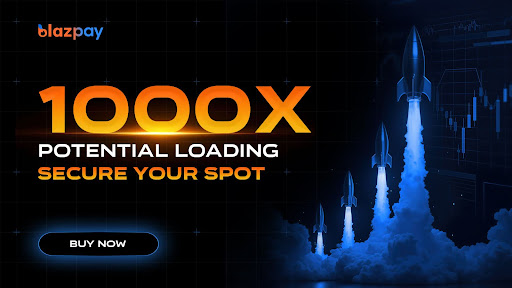
Join the Blazpay Community:
Website – https://blazpay.com
Twitter – https://x.com/blazpaylabs
Telegram – https://t.me/blazpay
Blockchain
Bitcoin and BNB Analysis: Blazpay Phase 5 Launches as Investors Hunt for the Top Crypto Coins to Buy
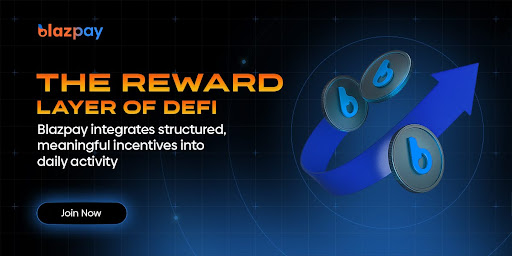
The crypto market continues to evolve with investors seeking high-potential tokens and utility-driven platforms. Among the best presale crypto opportunities, Blazpay stands out in Phase 5, attracting attention as one of the most promising AI crypto coins. Alongside established cryptocurrencies like Bitcoin and BNB, the presale offers an early entry point with asymmetric upside potential, making it a key focus for anyone evaluating the next crypto coins to buy
Blazpay Presale Phase 5 – The Smart Move for Crypto Investors
Blazpay has officially started Phase 5, with the price currently set at $0.0135 and scheduled to increase to $0.0135 after this phase closes. So far, 236M of the 249.04M BLAZ tokens have been sold, with $2.04M already raised. With AI-enhanced utilities, multichain support, and gamified services, Blazpay positions itself as a leading presale token among the best crypto presale platform options today.

Gamified Rewards and Perpetual Trading Benefits
Blazpay’s ecosystem combines gamified engagement with perpetual trading options. Investors are incentivized to complete milestones, participate in AI-driven tasks, and maintain long-term activity within the platform. The integrated AI provides automated trading suggestions, while multichain connectivity ensures fast, low-fee transactions across networks, making Blazpay a unique AI crypto coin presale with tangible utility.
Blazpay Referral Program – Rewarding Early Advocates
The Blazpay referral system allows investors to earn rewards whenever their referrals participate in the presale. This creates a compounding incentive for early adopters to expand their network and increase their token allocation, especially valuable during Phase 5, where the price is set to rise shortly.
Blazpay Price Prediction – Growth Potential in 2025
Industry analysts suggest that Blazpay’s Phase 5 presale positions the token for potential substantial gains post-launch. With AI-driven utilities, gamified rewards, and growing investor demand, projections suggest Blazpay could achieve significant milestones relative to established cryptocurrencies. Early-phase investors are particularly well-positioned to capitalize on future price movements.
Blazpay $2,000 Strategy – Early Entry Advantage
A $2,000 purchase during Phase 5 at $0.0135 secures roughly 170,213 BLAZ tokens. If the token reaches $0.05, the position grows to $8,511. At $0.10, it rises to $17,021. Should Blazpay hit $0.25, the investment could be worth $42,553. This demonstrates the asymmetric upside for early participants, making Phase 5 a key entry window.
How to Buy BLAZ
To participate before the Phase 4 supply sells out:
- Visit the official Blazpay presale page
- Connect your wallet (MetaMask, Trust Wallet, Coinbase Wallet)
- Select your preferred currency (ETH, BNB, USDT, SOL)
- Enter the amount you want to purchase
- Confirm the transaction and claim tokens after launch
Bitcoin (BTC) – Leading Crypto Coin to Buy for Institutional Exposure
Bitcoin (BTC) is trading at approximately $87,822 USD as of December 17, 2025, up 1.63% from the previous day. The digital asset continues to dominate the market, offering investors exposure to a proven store of value and hedge against inflation. Despite being 17% below last year’s highs, BTC shows strong institutional interest, with long-term holder supply at an 8-month low of 14.34 million BTC. With potential ETF inflows and ongoing adoption, Bitcoin remains one of the top crypto coins to buy for those seeking stability with growth potential in the digital asset space.
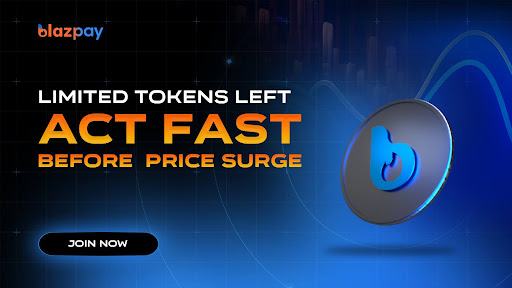
BNB – Established Blockchain Token Among Top Crypto Coins to Buy
BNB is holding steady around $857 USD, supported by $2.6 billion in 24-hour trading volume. The BNB Chain ecosystem continues expanding with initiatives like a new stablecoin targeting institutional usage, strengthening its utility in decentralized finance and trading platforms. While short-term fluctuations occur, BNB’s consistent network adoption and high liquidity make it a strong candidate among crypto coins to buy for investors looking to combine platform utility with long-term potential.
Conclusion
Blazpay’s Phase 5 presale offers investors the chance to access one of the most promising AI crypto coins early, with multichain utility and gamified rewards driving strong adoption. Complementing BTC’s store-of-value role and BNB’s utility-focused growth, this trio represents a strategic combination of new and established crypto assets. For investors seeking asymmetric potential alongside reliable blockchain leaders, Blazpay, Bitcoin, and BNB remain top crypto coins to buy in 2025.
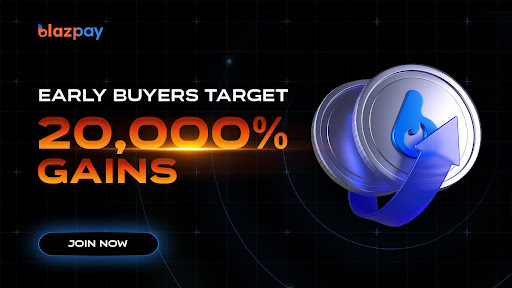
Join the Blazpay Community
Website: www.blazpay.com
Twitter: @blazpaylabs
Telegram: t.me/blazpay
FAQs
Q1. What makes Blazpay stand out among new crypto coins?
Its AI-enhanced automation, gamified services, and cross-chain capabilities differentiate it from traditional presale tokens.
Q2. How can I participate in Blazpay Phase 5?
Investors can buy BLAZ tokens via the official presale platform using the integrated steps for wallet connection and token purchase.
Q3. Why include Bitcoin and BNB in a presale portfolio?
BTC offers long-term stability, while BNB provides utility exposure in a major ecosystem, complementing early-stage tokens like Blazpay.
Q4. What is the risk/reward profile of Blazpay?
High potential upside due to Phase 5 presale pricing and AI-powered utility, balanced against typical early-stage crypto volatility.
Q5. How long until the next Blazpay price increase?
Phase 5 has just started, and the price will rise from $0.0135 to $0.0155 after completion.
Blockchain
DinoSol Debuts as a Meme-Driven Solana Token With Community-First Positioning

DinoSol (DINOSOL), a new entrant in the Solana meme-coin ecosystem, has launched with a strong emphasis on branding, simplicity, and early-stage community engagement. Built on Solana and centered around a playful, cartoon-styled dinosaur mascot, DinoSol joins the growing wave of culture-driven memecoins that leverage viral identity over utility-heavy roadmaps.
While still in its early development phase, DinoSol positions itself as a community-focused token aiming to expand through social momentum, low-cost Solana transactions, and a recognizable visual identity.
A Meme Coin Built on Solana’s High-Speed Infrastructure
DinoSol operates on the Solana blockchain, benefitting from fast, inexpensive transactions — a critical advantage for meme coin communities that thrive on rapid micro-trading, gifting, and community campaigns.
The project highlights accessibility as a core pillar: lightweight token mechanics, easy integration with Solana wallets, and a low barrier to entry for new users entering the meme token space.
Branding, Lore, and Community Identity
Unlike utility-first projects, DinoSol leans heavily on meme culture and its distinctive mascot. The design reflects exaggerated cartoon expressions, bright color themes, and a comedic aesthetic intended to resonate with viral crypto culture.
The branding suggests a lighthearted, entertainment-driven narrative — a key trait of recent memecoin successes.
DinoSol emphasizes community participation across its homepage and social channels, positioning the token as a collective movement rather than a structured technical product.
Tokenomics and Supply
Based on available public details, the token operates with a fixed supply model, a common approach in Solana meme tokens designed to reinforce scarcity and encourage early participation.
No complex staking, lockups, or reward mechanisms are described — aligning with its simplified meme-first positioning.
The focus remains on transparent supply, easy ownership, and frictionless trading.
Emerging Market Presence
As a newly listed asset on CoinMarketCap, DinoSol joins the expanding roster of Solana-based memecoins that have gained traction throughout 2025. While early trading metrics are still forming, interest has grown due to:
- Rapid community expansion
- Strong memeable branding
- Increasing visibility across Solana meme-fi culture
DINOSOL’s growth trajectory will depend largely on social momentum and how quickly the project can sustain community engagement.
Outlook
DinoSol is entering a highly active segment of the crypto market, where cultural resonance and simplicity often outweigh utility at launch. If meme sentiment on Solana continues to strengthen, DinoSol could benefit from the broader trend toward culture-and-community driven tokens.
For now, the project remains early-stage but well-positioned within Solana’s thriving meme ecosystem.
Blockchain
Blazpay AI Crypto Presale Announces Verified Audit as Phase 5 Surpasses $2.02M
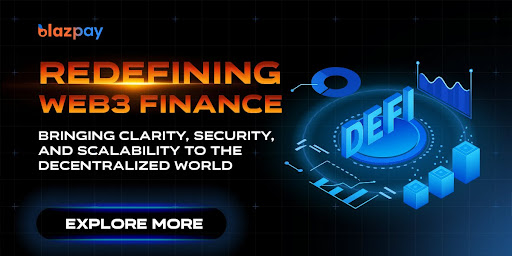
The Blazpay AI crypto presale continues to accelerate at an exceptional pace, crossing $2.02 million raised with 237.41 million BLAZ tokens sold out of 260.04 million in Phase 5 and reaching 91.3% completion. With the automatic price increase from $0.0135 approaching rapidly, Blazpay has now confirmed the successful completion of a full smart contract audit. This development amplifies investor confidence and positions Blazpay as one of the most secure, transparent, and high-potential projects in the AI crypto presale sector.
As the countdown to the Phase 5 price jump continues, audit verification has become the strongest catalyst driving new investors toward Blazpay, reinforcing its reputation as one of the best presale crypto opportunities and a clear top crypto to invest in for the upcoming AI-driven market cycle.
Audit Verification Brings Maximum Trust to the Blazpay Ecosystem
Blazpay’s verified audit confirms that its smart contracts, token mechanics, and operational frameworks meet the highest security standards. The audit report highlights that the system is free from critical vulnerabilities, and its AI orchestration layers meet strict transparency requirements. This level of validation is rare among early-stage blockchain projects and gives Blazpay a competitive advantage as the best crypto presale platform for investors seeking reliability alongside innovation.
The audit process examined the entire ecosystem, including the multi-chain settlement modules, the transactional infrastructure, and every segment of automated AI execution. The results confirm stability, efficiency, and immutability across the protocol, allowing investors to enter the AI crypto presale with confidence that contract logic and investor funds remain fully protected.
In a market where trust determines survival, Blazpay’s successful audit places it far ahead of non-audited competitors and positions it as one of the top crypto to invest in during this phase of the AI-powered blockchain expansion.
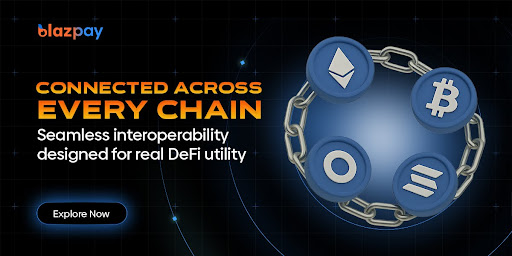
Why the Audit Strengthens Blazpay’s AI Utility Framework
Blazpay’s audit aligns directly with its expanding multi-utility AI ecosystem. The Conversational AI Execution engine enables users to interact with blockchain operations using natural language inputs, creating a frictionless AI-driven financial environment. The AI perpetual trading engine runs market analysis around the clock, delivering optimized trade execution without emotional interference. Blazpay’s multichain settlement network ensures smooth cross-chain movement of assets between Ethereum, BNB Chain, Polygon, and additional supported chains without depending on external bridges.
Developers have access to the Blazpay AI SDK, enabling the creation of AI-powered dApps, automation bots, and advanced infrastructure tools. The ecosystem also includes gamified AI rewards, encouraging user participation and continuous engagement.
These combined utilities gain significant credibility now that every operational module has been reviewed and verified by the audit, further elevating Blazpay as a leading AI crypto presale entering 2025.
Blazpay Price Forecast After Audit Verification
Analysts predict that the audit will strengthen Blazpay’s projected launch performance. The expected listing range for early 2025 sits between $0.03 and $0.05, supported by increasing demand and the completion of its AI utilities. Mid-term forecasts suggest a rise toward $0.15 to $0.25 by 2026 as the ecosystem gains real-world usage across decentralized applications and AI financial automation.
In a full market expansion, where AI tokens historically perform exceptionally well, Blazpay holds potential to reach the $0.75 to $1.00 zone. The audit outcome reinforces this projection by reducing risk and increasing investor confidence, solidifying Blazpay’s place among the best presale crypto investments of the current cycle.
$1,500 Audit-Backed Blazpay Accumulation Strategy
At the Phase 5 presale price of $0.0135, a $1,500 investment in Blazpay would secure approximately 111,111 BLAZ tokens. With audit-backed security, early participation comes with added confidence for investors positioning ahead of future price moves.
If Blazpay lists at $0.05, this allocation would be worth roughly $5,555. A rise to $0.25 in 2026 would increase the position to about $27,778, while a full bull-cycle surge to $0.75–$1.00 could elevate the value to between $83,333 and $111,111. The verified audit and structured presale make Blazpay a compelling high-upside option for AI-focused crypto investors.

How to Participate in the Blazpay AI Crypto Presale
- Visit www.blazpay.com
- Connect MetaMask or WalletConnect
- Choose USDT, ETH, or BNB
- Enter the amount you want to invest
- Confirm the transaction
Final Call Before the Price Increase
With Phase 5 now 91.3% complete and the price preparing to rise, this is one of the final opportunities to enter the AI crypto presale at an early rate supported by full audit verification. The audit eliminates uncertainty while Blazpay’s ecosystem continues expanding across multichain utility, AI automation, and developer integration. This combination positions Blazpay as one of the best presale crypto projects and one of the strongest candidates for investors seeking the best crypto presale platform before the next market surge.

Join the Blazpay Community
Website: www.blazpay.com
Twitter: @blazpaylabs
Telegram: t.me/blazpay
About Blazpay
Blazpay is an audited AI-powered blockchain ecosystem combining Conversational AI execution, automated perpetual trading, multichain interoperability, developer SDK integration, and gamified rewards under a unified network. Its newly verified audit ensures maximum transparency and security, making the Blazpay AI crypto presale one of the most secure and promising opportunities of 2025. With Phase 5 nearing completion and community growth accelerating, Blazpay stands out as a top crypto to invest in and one of the best presale crypto launches of the upcoming AI cycle.
-

 Crypto3 years ago
Crypto3 years agoCardalonia Aiming To Become The Biggest Metaverse Project On Cardano
-

 Press Release5 years ago
Press Release5 years agoP2P2C BREAKTHROUGH CREATES A CONNECTION BETWEEN ETM TOKEN AND THE SUPER PROFITABLE MARKET
-
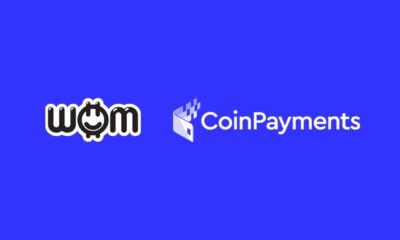
 Blockchain5 years ago
Blockchain5 years agoWOM Protocol partners with CoinPayments, the world’s largest cryptocurrency payments processor
-

 Press Release5 years ago
Press Release5 years agoETHERSMART DEVELOPER’S VISION MADE FINTECH COMPANY BECOME DUBAI’S TOP DIGITAL BANK
-
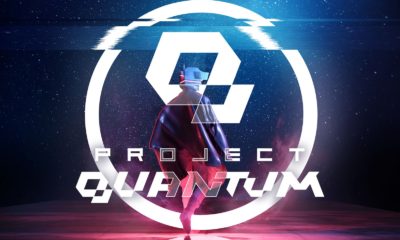
 Press Release5 years ago
Press Release5 years agoProject Quantum – Decentralised AAA Gaming
-

 Blockchain5 years ago
Blockchain5 years agoWOM Protocol Recommended by Premier Crypto Analyst as only full featured project for August
-

 Press Release5 years ago
Press Release5 years agoETHERSMART DEVELOPER’S VISION MADE FINTECH COMPANY BECOME DUBAI’S TOP DIGITAL BANK
-

 Blockchain6 years ago
Blockchain6 years ago1.5 Times More Bitcoin is purchased by Grayscale Than Daily Mined Coins

